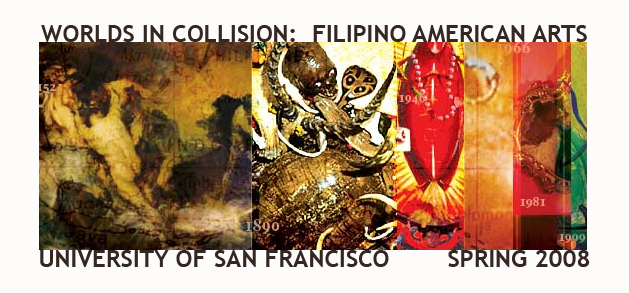MALAKAS AT MAGANDA: HYBRIDITY, MESTIZAJE, STRENGTH AND BEAUTY
IN-CLASS: TH 5/1, T 5/6, TH 5/8
DUE: TH 5/8
CRITIQUE: TH 5/8, T 5/13
Malakas and Maganda is one of a number of origin tales about how native Filipinos came to be.
One version:
When Bathala (God) was done creating the world, he was bored. He looked down over the earth and sent a bird into the world. The bird was flying around when it heard some sounds and tapping somewhere in the forest.The bird landed and found out that the sound is coming from a huge bamboo. He started pecking on it and pretty soon it split in the middle where a man came out of it. His name was Malakas, which means strong, and he told the bird, "My mate is in the other piece of wood." They got her out and her name was Maganda which means beautiful. The two got on the bird's back and flew away to find some place to live. They went flying around the world, and then finally, the bird saw a land and let the two giants set foot and live on it. When Malakas and Maganda stepped on the land their weight separated the land into islands (Philippines has 7,200 islands). Malakas and Maganda live on and produced millions of children, which came to be the Filipinos.
Another version:
Legend has it that the first Filipino man and woman were born from a bamboo stalk. They both had brown skin and supple bodies. The man was named Malakas, or "Strong One"; the woman, Maganda, or the "Beautiful One." Two traits which make the Filipino unique among its Asian neighbors -- their strength and resiliency despite a lot of adversity and trials which come their way; and their beauty which is reflected in their surroundings.
As the final project for a Filipino American Arts course, I am not asking you to literally illustrate the Malakas and Maganda legend, but I would like you to consider the nature of creation and cultural production in whatever aspect suits you best. For example, “Strength” and “Beauty” in this origin tale are gendered symbols of what makes creation possible, but how do these 2 words manifest most compellingly for you? Additionally, how do hybridity, mestizaje, and many other forms of synthesis play into a very contemporary sense of creation and growth?
This project can be as political, aesthetic and/or idealistic as you see fit: rage and hope are not mutually exclusive-- they are both galvanizing forces in creation. There is ample space for interpreting this project critically, formally and optimistically. Your artwork need not focus explicitly on Filipino content, but if it does, that’s absolutely fine. Given all of the things you’ve absorbed in this class, I would ask that you do explicitly address the connection between what you make and its relationship to what you’ve learned in Fil-Am Arts in your artist statement, which should be a bit longer (1 to 2 full pages, typed, double-spaced) than previous statements.
As you begin this project, please consider the guest artists, gallery visit to Bag’o/Neo, and other artists, readings and resources that we’ve covered in the past few weeks:
Charles Valoroso, Su Llamado, Stephanie Syjuco, Eliza Barrios and Renetta Sitoy were our guest speakers. The Bag’o/Neo show included works by Filipino artists Emily Caisip, John Yoyogi Fortes, Eliza Barrios, Cirilo Domine, and Pauletta Chanco. We looked at work in class by Chris Ferreria, Paul Pfeiffer, Michelle Lopez, Ariel Erestingcol, Gina Osterloh, and Gigi-Otalvaro Hormillosa. Su Llamado gave us a great information download on Roberto Villanueva and the Baguio Arts Guild. Let’s also not forget the artists on the Worlds In Collision website, as well as the artists you chose to write your papers on. You may find it helpful to refer to the most recent readings by Carol Becker, Dana Friis-Hansen, Gigi Otalvaro-Hormillosa, and Sabrina Alcantara-Tan, or to go further back to other readings that inspired you.
Project 3 is an opportunity for you to sift through these resources and inspirations and create work that may go in a wide array of directions: strength and beauty can be symbols of hope, faith, resistance, rebellion. You are free to interpret this broadly.
Project 3 is the final for this class: your artwork should be approached as the culmination of what you’ve learned in here. Your content should be stronger, the increased time and effort you put into this project should be evident, and your technical execution should demonstrate growth from your 2 prior projects.
Project 3 can be in any visual arts medium: this is your opportunity to experiment with other forms, strategies and media, so long as it feels appropriate and relevant to your project. Please continue to push yourself beyond your comfort zone with whatever material you choose.
Project 3 should look like the culmination of 2-3 weeks of deep work, regardless of materials chosen. Your work should look completely resolved by its due date. If you are confused about this project, please set up a meeting with me.
Project 3 is due Thursday 5/8, with critiques split over 5/8 and 5/13. Since we have more class-time on 5/13, to accommodate slightly longer, more complex discussions about each other’s work, critiques will be longer this time: 15-ish minutes each.
Criteria for success on Project 3:
- Creative and intellectual interpretation of “Malakas at Maganda” as the theme
- Engagement with notions of hybridity and mestizaje, literally or figuratively
- Synthesis of materials covered in the last 1/3 of Fil-Am Arts
- Materials/media/execution appropriate to your project
- Evidence of engagement and complex investment in idea, theme and execution
- Technical and artistic growth since Projects 1 and 2
- 2-3 weeks of deep work, effort and investment (12-13 hours minimum)
- fully-resolved work
- longer, more complex written reflection/artist statement (1-2 pages typed, double-spaced)













